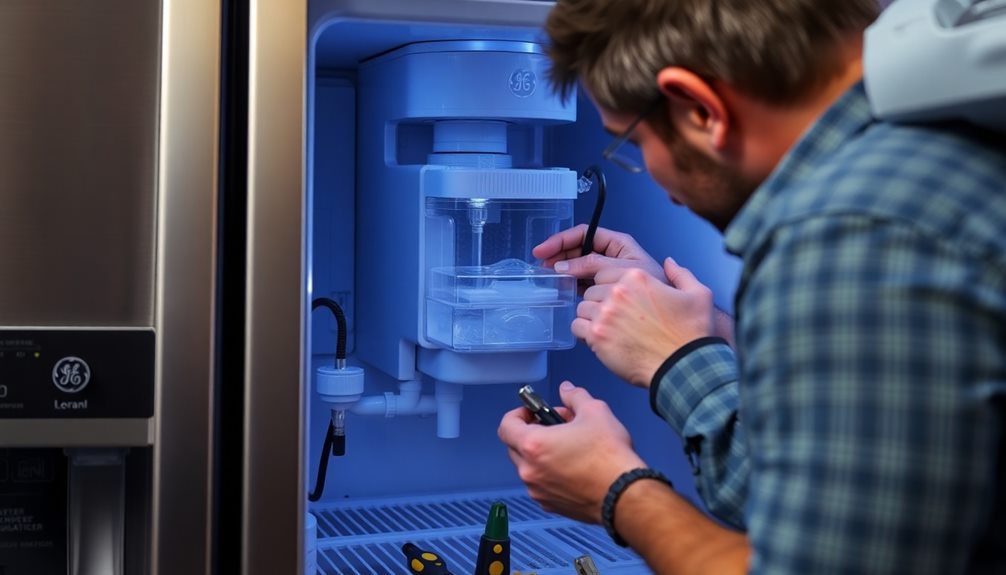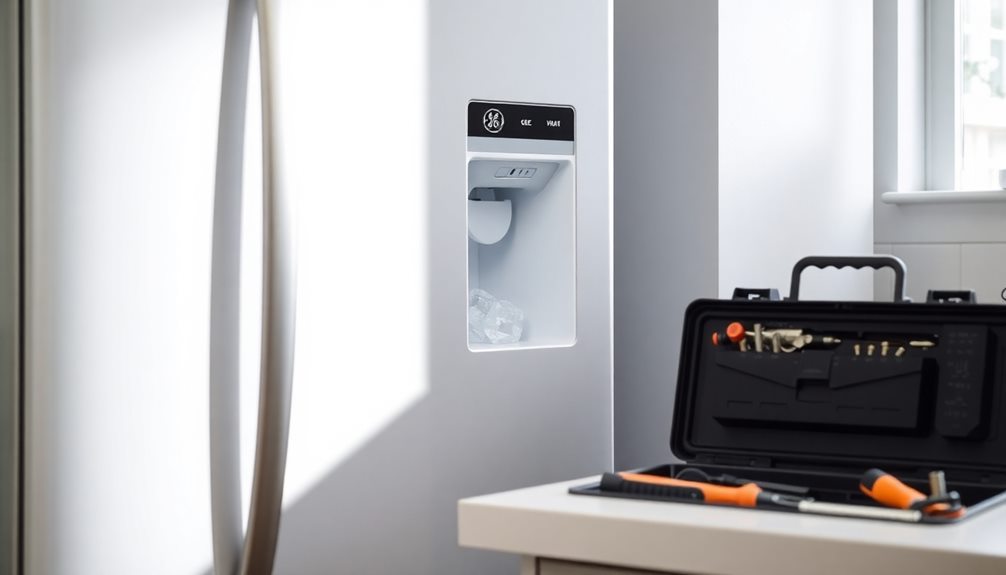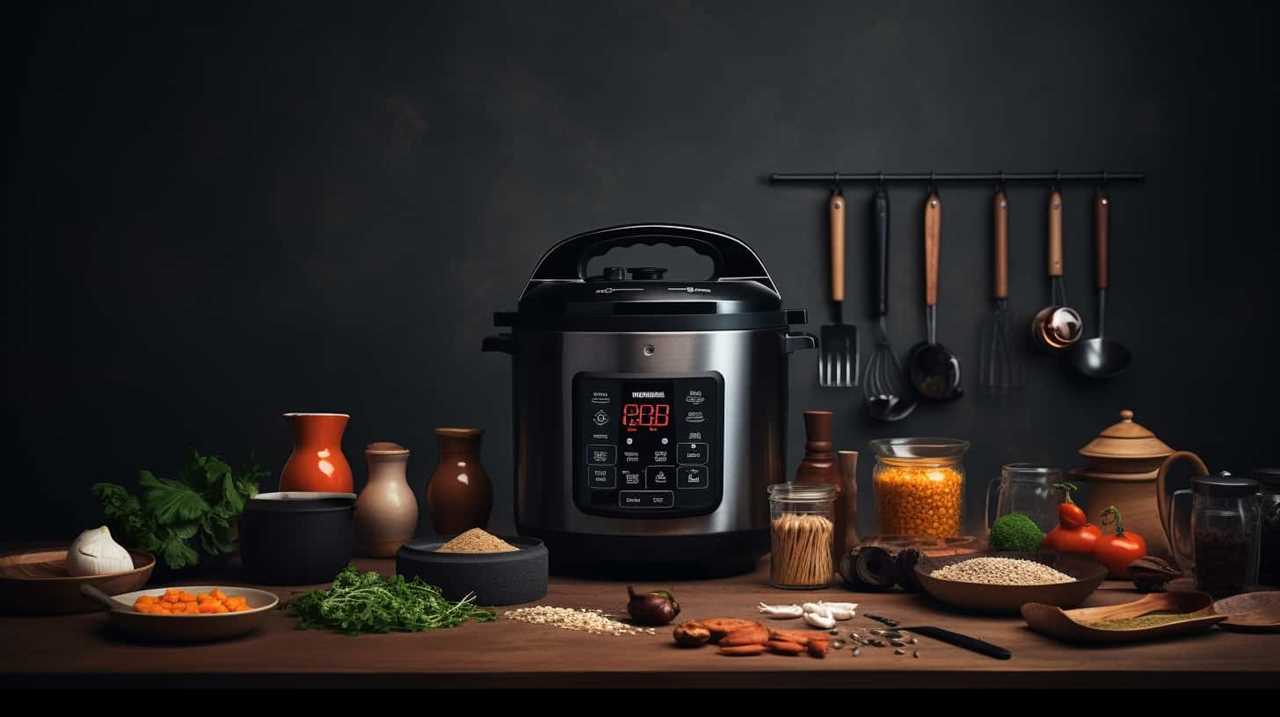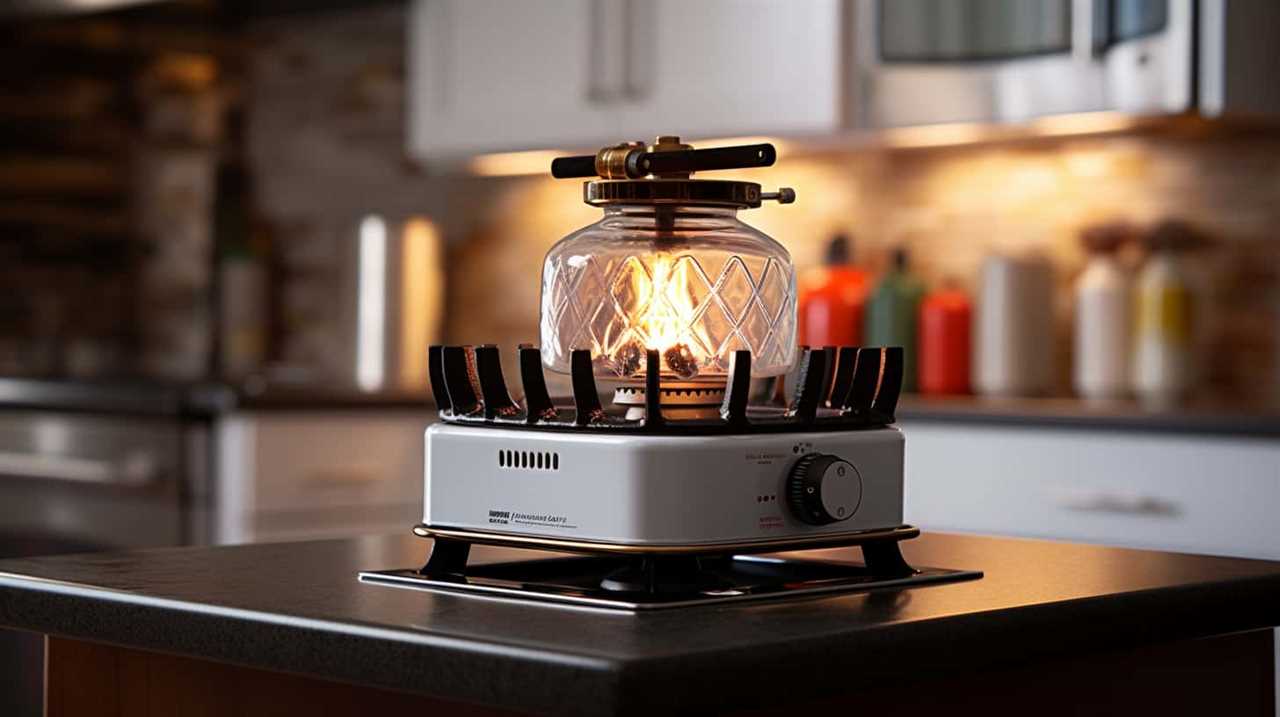If your GE refrigerator is not dispensing water or ice, be sure to check for frozen water lines or blockages in the water inlet. Ensure the freezer temperature is set between 0°F and 10°F. Replace the water filter if it has been more than six months since your last change. Check for kinks in the water line and make sure all connections are secure. If the issue continues, examine the door and dispenser switches for any continuity problems. These basic solutions often resolve the issue, but there is more to investigate to ensure your refrigerator operates smoothly.
Key Takeaways
- Check and replace the water filter if it hasn't been changed in the last six months to restore water flow.
- Inspect the water line for kinks or blockages to ensure a proper connection to the water supply.
- Confirm that your refrigerator and freezer temperatures are set between 0°F and 10°F to prevent freezing issues.
- Test the water inlet valve with a multimeter; replace it if defective to restore dispensing capabilities.
- Thaw any frozen water lines using a hair dryer on the lowest setting to improve water flow.
Common Issues With GE Fridges

When it comes to GE refrigerators, several common issues can pop up, often leaving you frustrated. One major problem is a frozen water line, which can prevent your water dispenser from working while still allowing the ice dispenser to produce ice.
You might notice that even after changing the water filter, the dispensers fail to operate. This could be due to air trapped in the water supply or frozen supply tubes.
Another frequent complaint involves leaking ice makers and dispensers, especially with indoor water dispensers that can suddenly stop functioning. If you find water pooling under your GE refrigerator, it's likely a sign of a leaking ice maker.
Additionally, issues with the water filter housing can raise concerns about the reliability of the design across different models.
Keep in mind that low freezer temperatures, particularly those below 0°F, can contribute to frozen water lines, greatly affecting your refrigerator's dispensing capabilities.
Addressing these common issues promptly will help you get your GE refrigerator back to normal, ensuring you have access to fresh water and ice when you need it.
Troubleshooting Steps to Follow

To get your GE fridge back in working order, start by tackling the most common issues with a systematic approach. Here are some troubleshooting steps to follow:
- Check the water filter: If it hasn't been replaced in the last six months, do so. A clogged filter can greatly restrict water flow and ice production.
- Inspect the water line: Look for any kinks or blockages. Verify it's properly connected to the water supply to allow adequate water flow.
- Test the water inlet valve: Use a multimeter to check its functionality. If it's defective, you'll need to replace it to restore water and ice dispensing.
- Verify refrigerator temperature: Confirm that both the refrigerator and freezer temperatures are set between 0°F and 10°F. This prevents the water line from freezing, a common issue in GE models.
Additionally, check the door switch and dispenser switch for continuity. Malfunctioning switches can prevent proper dispensing.
Repair and Replacement Options

Repairing your GE fridge's water and ice dispenser often requires a straightforward approach to replacing faulty components.
Start with the water inlet valve; if it's defective, it can block water flow even if the ice maker works fine. Check the water filter housing for cracks or blockages, which can restrict water flow. Remember to replace the filter every six months for peak performance.
If you have frozen water lines, try thawing the line with a hair dryer set to the lowest setting. Insulating the freezer door can help prevent future freezing issues.
Additionally, if the dispenser switch is faulty, you may need to replace it. Use a multimeter to test the switch for continuity to see if it's functioning properly.
For ongoing problems, don't hesitate to call a professional technician. They've the expertise to diagnose and repair issues related to the control board or other complex components that might be affecting your dispenser's performance.
Taking these steps will help guarantee your GE fridge's water and ice dispenser works efficiently again.
Preventive Maintenance Tips

Maintaining your GE fridge's water and ice dispenser is key to preventing future issues. By following these preventive maintenance tips, you can guarantee peak performance and avoid common problems:
- Replace the water filter: Change your refrigerator's water filter every six months to prevent clogs that can impede water flow and affect ice production.
- Monitor freezer temperatures: Keep your freezer between 0°F and 10°F to reduce the risk of freezing water lines and maintain proper dispensing functionality.
- Clean the water dispenser line: Periodically clean this line to eliminate sediment buildup, which can restrict water flow and lead to malfunction.
- Check door seals: Inspect the door seals for wear and tear. Proper insulation helps maintain consistent refrigerator temperatures and prevents freezing in water lines.
Additionally, conduct routine checks on the water supply line for any kinks or blockages.
Taking these steps guarantees that your GE fridge consistently dispenses water and ice without issues, enhancing your overall experience with this essential appliance.
User Experiences and Solutions

When users run into issues with their GE fridge's water and ice dispenser, they often find that simple solutions can make a big difference.
For instance, many have discovered that frozen water lines are a common culprit, easily resolved by adjusting temperature settings or thawing the lines with a hair dryer. If your ice maker isn't functioning, check for a defective door switch, as it can disable the dispenser when the door is open. A quick test with a multimeter can confirm if the switch is working.
Another frequent solution involves the water inlet valve. Users have reported checking this valve for blockages; if water flows well but the dispenser is still non-functional, replacing the inlet valve might be necessary.
After installing a new water filter, remember to flush the system by running the dispenser for several minutes. This helps eliminate air pockets and sediment buildup that can hinder water flow.
Expert Recommendations

To guarantee your GE fridge's water and ice dispenser works efficiently, start by keeping the refrigerator temperature set between 0°F and 10°F. This range helps prevent frozen water lines and reservoirs, which can hinder your water dispenser and ice maker's performance.
Here are some expert recommendations to troubleshoot common dispensing issues:
- Replace the Water Filter: Change your water filter every six months, or sooner if you notice signs of clogging. A clogged filter can greatly restrict water flow to the dispenser.
- Test the Water Inlet Valve: Verify the water inlet valve is functioning correctly. A malfunctioning valve can block water from reaching your water dispenser and ice maker.
- Inspect for Frozen Water Lines: If you suspect freezing, inspect and thaw any frozen water lines. You can use a hair dryer on a low setting for this purpose, especially around the door or reservoir.
- Check the Door Switch: Confirm that the door switch has continuity. A defective switch can disable the dispenser when the refrigerator door is open, leading to dispensing issues.
When to Seek Professional Help

Sometimes, despite your best efforts with troubleshooting and maintenance, your GE fridge's water and ice dispensers might still act up. If the dispensers are completely unresponsive after confirming the water supply is connected, it's time to evaluate a professional diagnosis. This could indicate issues with the control board or other electrical components.
If you find that water flow remains problematic even after regular maintenance and filter changes, underlying mechanical problems may be at play. In such cases, consulting a certified technician is essential. If you've checked for frozen lines and blockages but the issue persists, the water inlet valve or micro switch might need professional replacement.
Listen for any buzzing or unusual sounds from your fridge. These could signal mechanical failures that require immediate attention from a repair expert to avoid further damage.
For recurring issues that haven't improved despite your DIY methods, it's wise to reach out to a technician. They can provide expert insight into potential design flaws or systemic problems that you mightn't be able to resolve on your own. Taking these steps can save you time and money in the long run.
Frequently Asked Questions
Why Is My GE Refrigerator Not Dispensing Water or Making Ice?
Your GE refrigerator might not dispense water or make ice due to a frozen water line, a clogged filter, a faulty water inlet valve, or a malfunctioning door switch. Check these components to troubleshoot effectively.
Why Is My Refrigerator Making Ice but Not Dispensing Ice or Water?
If your refrigerator's making ice but not dispensing it or water, check for a clogged water line, inspect the filter, and verify the water inlet valve and door switch are functioning properly.
Why Is There No Water Coming Out of My GE Refrigerator?
If there's no water coming out of your GE refrigerator, check the water filter, inspect for frozen lines, and verify the supply valve's open. You might need to test the door switch for faults too.
How Do You Reset a GE Refrigerator Water Dispenser?
Did you know that nearly 20% of refrigerator owners face water dispenser issues? To reset your GE fridge, unplug it for five minutes, check the water line, and verify the filter's properly installed before testing again.
Conclusion
To sum up, if your GE fridge isn't dispensing water or ice, don't panic—you can often resolve it with a few simple troubleshooting steps. Did you know that nearly 20% of refrigerator issues stem from clogged water filters? By regularly replacing your filter, you can prevent many common problems. Remember, a little preventive maintenance goes a long way in keeping your fridge running smoothly. If all else fails, don't hesitate to call in a professional for help.










